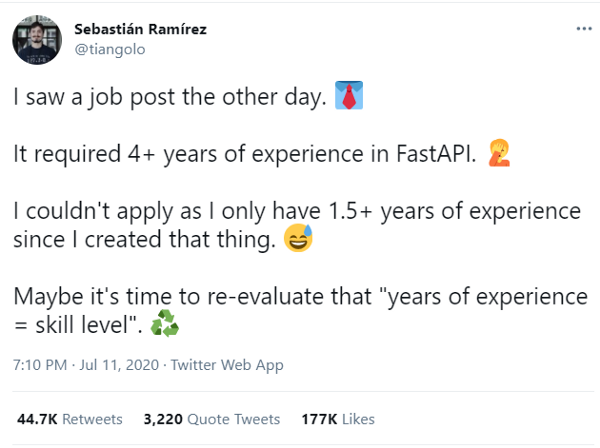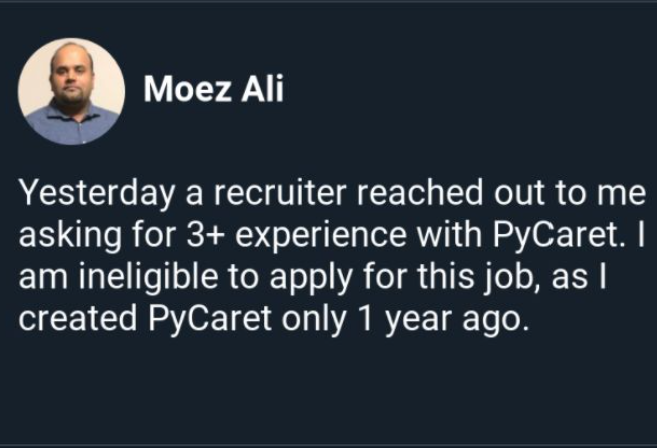The Ideal Data Scientist Doesn’t Exist (and Hiring Managers Know This)

Have you ever stared at job postings, worrying you don’t have the skills yet?
Have you ever wished to get into the minds of a hiring manager?
Have you ever applied to multiple jobs only to never hear back from any?
I have. I have. Of course, I have.
I know you said yes to at least one of the questions, if not all three. At different points of my journey, I had the same questions too. When I felt I had learned enough data science and built a portfolio, I started applying for jobs online. Soon enough, I realized the typical strategy was terrible.
So I changed my strategy slightly. I’d customize my CV to fewer jobs and request a referral from someone in my network. It worked better, but I had no idea what the hiring manager was looking for when I walked into the interview.
I’d fumble because I had no confidence. This kept repeating for a while till I luckily got my breakthrough. Four years into this field and industry, I realize I was stupid all along. Yeah, stupid is the right word.
In this article, I’ll clear all the myths and doubts in your mind, and when we are done, you’ll have a clear strategy to attack your data science job search. Trust me on this, and keep reading till the end.
Here’s a Sneak Peek into the Hiring Manager’s Mind
This is a real story from a few years ago. Along with new, potential projects came the need to hire a bunch of data scientists. Soon we were outlining job descriptions and setting up advertisements to post online.
The head of data science, also the hiring manager, took ownership of this. When we saw the finalized job description, we were confused. Here we are a bunch of data scientists with less than three years of experience, but the new data scientist had to have at least five years. That’s what the advert said anyway.
I being an inquisitive team member, asked him what was going on. What he told me surprised me:
“What if there’s someone out there with 5 years of experience? You know, experienced folks are always better, we can learn from them. They would never apply if we ask for only 3.”
Clever, but there was a problem.
I informed an ex-colleague who was looking for opportunities regarding this vacancy. Despite reminding him twice, I didn’t receive his CV or the application. I assumed he had some other plans and left it as it is.
Months later, when I met him, he was still open to opportunities. I was ready to refer him for a job he’d be a great fit, which he ignored, yet he’s still looking for opportunities. It didn’t make sense. Why would he do that?
“Man, I went through the job details you shared, and I think they’re looking for a senior person. I’m not there yet. I still need to improve my data science skills. I know I’m not a good fit, so there was no point applying.”
Do you see where this is heading towards? On the one hand, hiring managers create job descriptions for ideal candidates, despite knowing they don’t exist. On the other hand, suitable candidates hesitate to apply because of the unreasonable skills required.
As data science aspirants, we don’t have control over what hiring managers do, but we can interpret the job requirements better.
What this means to you:
Most job descriptions are wishlists of hiring managers who don’t want to miss out on the ideal candidate. Period.
They know the ideal ones hardly exist and are perfectly fine with someone who doesn’t 100% match the requirements they put out.
Most professionals in the industry know what’s going on, but aspiring data scientists are unaware of this. Sebastián Ramírez needed 4 years of experience in a library he created 1.5 years earlier. Moez Ali, the creator of the PyCaret library, came across a similar scenario.


So what’s the solution to this problem? Bulk applying won’t solve this; it’d make things worse. The answer is something called “The 60% Rule,” which we are about to decode.
Use This ‘60% Rule’ before Applying for Jobs
One of the best books I’ve read about building a career in data science was by Emily Robinson and Jacqueline Nolis. Amongst all the valuable information, one idea stood out and resonated with my strategy.
It’s the 60% rule.
“If you fulfill ≥60% of the job requirements, you’re already prepared for the job. Think no further and apply.”
Being in the industry for close to 4 years, I can vouch that this is true. Once you get into the industry, you’ll intuitively understand that this works, but trust us on this and use this rule for the time being.
What this means to you:
Whenever you come across a job description, be honest with yourself.
Ask yourself some of these questions:
- If the role requires 3 years of experience, ask do I have at least 2 years of experience?
- If they require you to know R, Python, and Scala, do I know at least two of them well?
- Scikit-learn, Tensorflow, and PyTorch. Am I comfortable with any of 2 of 3?
- You get the idea. In a nutshell, if they have listed 10 requirements, do I satisfy at least 6 of them?
Be honest and don’t overthink.
Applying right will give you the needed boost in confidence which is critical in facing the interviews that’ll follow. By now, you understand the mindset of the hiring manager. You also know to select which jobs you’d be applying to. What do you do next?
How to Make Sure You’re a Great Fit
Referrals help you maximize the chances. But truth be told, it’s not always possible. In such scenarios, you should try to customize your CV to fit the job you’re applying to.
Here’s how to do this:
- You start by taking the skills listed in the job description and select the ones you’re good at.
- Make sure to use these exact keywords in your CV. If the recruiters manually scan or run your CV through an automated Application Tracking System (ATS), you’re sure to come out as a great fit.
- The most common mistake job seekers make is to add skills they’re not comfortable with. Don’t be them. They end up fumbling in the interview when tested on those skills. You’re not expected to know everything, but you should know everything that’s on your CV.
I know this advice sounds simple, but you won’t believe how few people follow this. Pause for a second and try to recall the last time you customize your CV for a job role. Chances have you used the same CV for multiple applications — I did too.
The art of breaking into data science lies in applying less and ensuring you stand out.
Your Actionable Takeaway
Breaking into data science is hard. The hiring managers make it worse with their unrealistic expectations. We either keep bulk-applying without any response, or we end up not applying at all.
We can’t do much about how things work in the industry, but here’s the recap of what we can do to maximize our chances:
- Let’s stop bulk applying to jobs. It will never do any good.
- Please take the time to read the job descriptions.
- Understand those job descriptions are merely the wishlists of hiring managers.
- Don’t be deceived by the job title, but look further into the skills required.
- See if you match a minimum of 60% of the skills required. Yes? You have a shot at this job, else move on to the next.
- Customize your CV to the job role you're applying for. Use exact keywords.
- Ace the interview. You got this!
I used this strategy and started getting more responses and eventually offers from companies. I’m optimistic this would work for you. You’ve got nothing to lose but a lot to gain.
Give it a shot?
For more helpful insights on breaking into data science, authentic experiences, and learnings, consider joining my private list of email friends.

